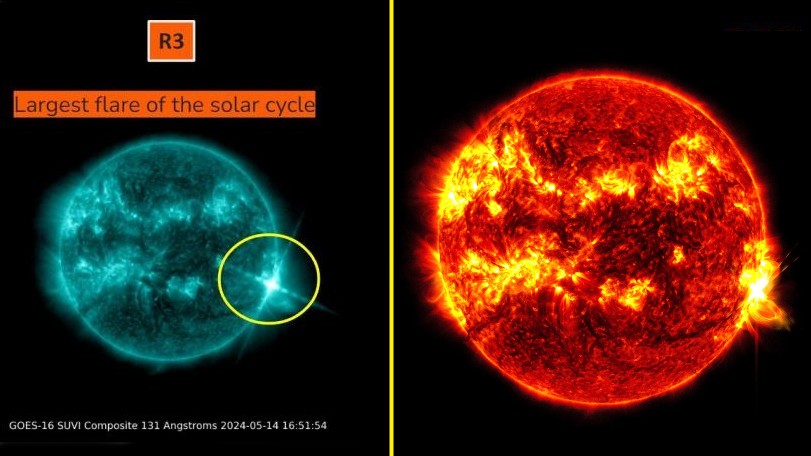Sun launches strongest solar flare of current cycle in monster X8.7-class eruption
The strongest solar flare in half a decade just launched off the sun from the same sunspot group that triggered dazzling auroras last weekend. But don't expect northern lights this time around.

The sun has just spat out the strongest solar flare of the current solar cycle, which began in 2019, according to a breaking report from the National Oceanic and Atmospheric Administration's (NOAA) Space Weather Prediction Center.
The monster flare is a category X8.7, making it considerably stronger than the X2.2 flare that erupted from the sun last week — triggering radio blackouts and widespread auroras on Earth that were visible as far south as Mexico.
However, the latest flare is unlikely to result in any geomagnetic storms or aurora activity, as the sunspot group responsible for the blast is located at the very edge of the visible side of the sun, according to NOAA. However, high-frequency radio blackouts are still likely on Earth.
If the flare produces any coronal mass ejections (CMEs) — gigantic, high-speed plumes of charged solar particles — they are not likely to impact Earth directly, as was the case during last weekend's vibrant display of auroras.
That said, the same monster group of sunspots — which is called active sunspot region 3664 and measures more than 15 Earths wide — is responsible for both last week's X2.2 flare and today's X8.7 flare, NOAA reported. The grouping has spat out numerous other X-class flares over the past several days, but it will soon be entirely out of view of our planet.
Solar flares are powerful bursts of electromagnetic radiation that result from magnetic disturbances on the sun. They occur when magnetic field lines in the sun's atmosphere tangle and snap, releasing large amounts of excess energy, including powerful X-rays and ultraviolet radiation. These twisted lines emerge from sunspots — darker, cooler regions on the sun's surface that form when magnetic fields from deep within our star push up to the surface.
Sign up for the Live Science daily newsletter now
Get the world’s most fascinating discoveries delivered straight to your inbox.
CORRECTION to previous post:Flare magnitude 8.7, not 8.8. pic.twitter.com/NSdmhTWIYHMay 14, 2024
Solar flares can also launch CMEs outward into space, hitting any planets, satellites or other objects in their path. CMEs that hit Earth trigger geomagnetic storms, which can result in auroras, as well as negative effects such as power grid failures and satellite malfunctions.
All of these extreme solar phenomena — solar flares, sunspots and CMEs — become more common during the peak of the sun's 11-year activity cycle, known as solar maximum. The current cycle, solar cycle 25, began in 2019, and scientists suspect that the sun may soon enter its solar maximum phase, if it hasn't already. Only after the maximum ends, and solar activity dies down again, will scientists know for sure when it peaked.
The sun hasn't spat out any flares stronger than X8.7 since September 2017, when it emitted an X11.8 and X13.3 flare within a few days of each other, according to spaceweatherlive.com.

Brandon is the space/physics editor at Live Science. His writing has appeared in The Washington Post, Reader's Digest, CBS.com, the Richard Dawkins Foundation website and other outlets. He holds a bachelor's degree in creative writing from the University of Arizona, with minors in journalism and media arts. He enjoys writing most about space, geoscience and the mysteries of the universe.










